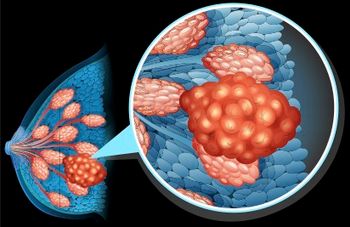
- ONCOLOGY Vol 12 No 1
- Volume 12
- Issue 1
Fluorouracil-Based Combinations in the Treatment of Metastatic Breast Cancer
Although combination chemotherapy regimens may prolong survival for selected patients with metastatic breast cancer, few, if any, are cured. The standard regimens used in treatment, eg, CMF (cyclophosphamide,
ABSTRACT: Although combination chemotherapy regimens may prolong survival for selected patients with metastatic breast cancer, few, if any, are cured. The standard regimens used in treatment, eg, CMF (cyclophosphamide, methotrexate, and fluorouracil [5-FU]), FAC (5-FU, Adriamycin, and cyclophosphamide), and FEC (5-FU, epirubicin, and cyclophosphamide), were developed over a decade ago. Current efforts to improve therapeutic efficacy have concentrated on decreasing drug toxicity and increasing drug doses (eg, high-dose chemotherapy with peripheral stem-cell support). An important alternative approach to increasing therapeutic efficacy focuses on altering the administration schedules of well-known chemotherapeutic agents and introducing active new agents. One of the most frequently used cytotoxic drugs, fluorouracil (5-FU), has documented activity in a variety of malignancies, most notably, breast cancer and gastrointestinal tract cancers. However, despite broad clinical experience with 5-FU, our knowledge about the mechanisms of resistance to the various administration schedules used is limited. In vitro data and clinical experience show that resistance to one schedule of 5-FU can be overcome by using alternative schedules, in particular, a protracted infusion. This article discusses our clinical experience with weekly high-dose 24-hour infusions of 5-FU in combination with folinic acid (leucovorin) alone and together with paclitaxel (Taxol) for the treatment of advanced breast cancer.[ONCOLOGY 12(Suppl 1):31-35, 1998]
During the 1990s, one in nine women in the western world will be diagnosed with breast cancer in their lifetime, and more than 58,000 will die of the disease each year in Europe alone. Recent changes in the primary treatment of operable breast cancer have not altered patient prognosis. Adjuvant therapy delays systemic recurrence and improves survival for only a select fraction of these patients.
Therapy for metastatic breast cancer has not improved significantly in recent years. Although many combination chemotherapy regimens result in high response rates, complete remissions occur in fewer than 20% of patients, and median survival is generally 2 years. In women who do not respond to primary therapy for metastatic disease, complete remissions are infrequent, with overall response rates for most regimens ranging from 10% to 35%.[1] Given the dearth of active agents capable of inducing durable remissions in metastatic breast cancer, there is clearly a need for new therapeutic strategies, as well as the incorporation of new drugs into these strategies.
Results of studies have suggested that fluorouracil (5-FU) administered by continuous infusion has significant clinical activity in heavily pretreated breast cancer patients, with reported response rates of 25% to 40%.[2-4] A substantial body of experimental data indicates that the addition of pharmacologic concentrations of reduced folates to human tumor cells in vitro enhances both the duration and degree of thymidylate synthase inhibition produced by 5-FU.[10-12]
Studies have shown that folinic acid (leucovorin) enhances the therapeutic activity of 5-FU, especially in colorectal carcinoma.[5-8] In order to extend this area of biochemical modulation and build on the results obtained with a monthly schedule of 5-FU/folinic acid in advanced colorectal carcinoma, several groups performed phase II trials using this combination in patients with previously treated metastatic breast cancer.[1,9] The results of these studies indicated that the combination has a significant therapeutic effect and can be administered with an acceptable level of toxicity in this palliative situation.
Moreover, several phase II trials have shown that 5-FU plus folinic acid is active in breast cancer patients pretreated with anthracycline-containing regimens.[1,13-15] In these trials, folinic acid and 5-FU were usually administered by bolus injection. However, phase II studies in colorectal cancer have suggested that weekly administration of high-dose folinic acid in combination with high-dose 5-FU given as a continuous 24-hour IV infusion induces higher overall response rates.[16] Similarly, our in vitro and clinical data indicate higher activity when this combination is given as a protracted infusion.[2-4,32]
Weekly 24-Hour Infusion of 5-FU Plus Folinic Acid
Based on these results, we performed a phase I/II study of weekly high-dose 5-FU/folinic acid in patients with heavily pretreated metastatic breast cancer (ie, at least two prior treatment regimens).[17] All patients included had to have bidimensionally measurable disease. In the phase I portion of this study, folinic acid (500 mg/m² via a 2-hour IV infusion) was followed by 5-FU (2 g/m² via a 24-hour IV infusion) once weekly for 6 weeks followed by 2 weeks rest. Our data demonstrated that folinic acid and 5-FU can safely be administered at these doses.
The response rate achieved in the 32 patients treated during the phase II portion was 41% (95% confidence interval [CI], 24% to 58%) with a median response duration of 11 months. Similar results were observed in the anthracycline-resistant subgroup of patients (resistance defined as progression while receiving anthracycline-containing chemotherapy).
Paclitaxel Plus Weekly High-Dose 5-FU/Folinic Acid
Our encouraging data using weekly high-dose 5-FU/folinic acid in the treatment of heavily pretreated breast cancer patients, and the promising antineoplastic activity of the tubulin-binding agent paclitaxel (Taxol) when given as second-line single-agent treatment in metastatic breast cancer[19-25] led us to initiate, in September 1993, a phase I/II study using paclitaxel in combination with weekly high-dose 5-FU/folinic acid.[31] Patients were treated with weekly high-dose 5-FU (24-hour) plus folinic acid (2-hour infusion prior to 5-FU) for 6 weeks; in addition, paclitaxel (3-hour infusion) was administered on days 1 and 22 after standard premedication with corticosteroids and histamine-1- and histamine-2-receptor antagonists. Each cycle comprised 6 weeks followed by 2 weeks rest. All patients were treated on an outpatient basis using IV port systems and portable pumps.
First, a classic phase I study was performed in 16 patients, four at each of four dose levels. These 16 patients underwent 56 treatment cycles. No dose-limiting toxicities occurred at dose levels 1 to 3. Because of the moderate toxicity at dose level 4, together with responses (partial responses) seen at all dose levels in two of the four patients, dose level 4 was selected for further evaluation during phase II of the study (Figure 1).
A total of 46 patients were evaluated further for response in phase II. All had measurable disease. Thus far, 35 patients are evaluable for response; 11 patients are at too early a stage to evaluate. Tables 1 and 2 summarize the characteristics and pretreatment patterns in the entire group of 46 patients.
The 46 patients have received 108 treatment cycles, with a median of three treatment cycles per patient (range, one to five). Alopecia (World Health Organization [WHO] grade 3) was common. The incidences of other toxicities are shown in Table 3. No serious acute hypersensitivity reactions to paclitaxel were observed.
Neutropenia was common but was mild to moderate in severity in most patients. No hospitalizations because of febrile neutropenia were necessary. The duration of grade 3 or 4 neutropenia was generally brief. No cytokines were used.
Besides alopecia, nonhematologic toxicities consisted mostly of mild to moderate myalgia, diarrhea, mucositis, nausea and vomiting, and hand-foot-syndrome (Table 3). Peripheral polyneuropathy was cumulative, was mild to moderate in severity, and occurred mostly during the third treatment cycle.
Responses in the entire group of patients are summarized in Table 4. Complete remissions occurred in 3% of patients (1/35), partial remissions in 51% (18/35), stable disease in 40% (14/35), and progressive disease in 6% (2/35). Thus, the overall response rate was 54% (95% CI, 37% to 69%).
Responses in the 20 patients with anthracycline-resistant disease (defined as progression while receiving anthracycline-containing chemotherapy) were analyzed separately (Table 5). In this subgroup, the response rate was 55% (11/20; 95% CI, 34% to 76%).Time to maximum response was 2 months (range, 1 to 5 months) remission duration was 8+ months (range, 2 to 11 months), and median follow-up was 6 months.
The results of our studies must be analyzed in the context of all phase II studies of the treatment of anthracycline-resistant metastatic breast cancer. This situation is a negative prognostic factor for response to salvage chemotherapy. The collected phase II experience shows that, after prior exposure to anthracyclines, second- or third-line chemotherapy induces objective remission rates of 15% to 30% at best.[18]
Previous studies have shown that conventional doses of 5-FU/folinic acid achieve a 29% response in patients who have received one prior treatment regimen and a 22% cumulative response rate in patients who have received two prior treatment regimens.[1,9,13-15] In our study of weekly high-dose 24-hour 5-FU in combination with folinic acid, the results seemed to be superior to those of conventional 5-FU/folinic acid bolus therapy, as discussed previously.[17] The introduction of a new class of active drugs in breast cancerthe taxanes (paclitaxel and docetaxel [Taxotere])offered a chance to further improve therapeutic outcome.[19-24]
In the phase I/II study described above, as well other phase I/II studies,[29] we showed that other drugs (cisplatin [Platinol], paclitaxel) can be safely added to weekly high-dose infusional 5-FU without compromising dose and dose intensity and without increasing toxicities to an intolerable degree. The latter fact is of crucial importance in view of the palliative intent of salvage chemotherapy in advanced breast cancer patients.
Furthermore, the combination of paclitaxel with weekly high dose 5-FU/folinic acid was well tolerated and can safely be administered under outpatient conditions. Despite full doses of both 5-FU and paclitaxel, only 14% and 7% of all treatment cycles were associated with WHO grade 3/4 myelotoxicity and diarrhea, respectively. Most side effects were mild and of short duration.
Of note is the 54% response rate induced by high-dose 5-FU/folinic acid/paclitaxel in patients who had received prior chemotherapy, especially those who had anthracycline-refractory disease. The results of our study thus far are noteworthy when compared with those of other combinations in the second-line treatment of advanced breast cancer.
Fluorouracil is the classic example of a cycle-specific S-phase-dependent drug with a short half-life (10 to 20 minutes).[40] It is therefore reasonable to postulate that conventional bolus injection may not be the most effective administration schedule for this drug.
UFT is composed of 1-(2-tetrahydrofuryl)-5-fluorouracil (ftorafur [Tegafur]) and uracil in a molar ratio of 1:4. It is an orally available agent that appears to have activity comparable to intravenously administered 5-FU in combination with leucovorin.[35-39] Thus, the introduction of oral UFT may allow for the administration of long-term low-dose oral 5-FU with the same pharmacokinetic profile as a continuous IV infusion.
In our new study, we plan to substitute weekly oral UFT plus leucovorin for high-dose 5-FU plus folinic acid. Oral UFT given daily for 14 days allows for prolonged exposure to the drug without the need for a central catheter or an infusion pump. Considering the clinical and experimental data described above, the combination of paclitaxel plus UFT and leucovorin warrants investigation as salvage chemotherapy in metastatic breast cancer. Therefore, the appropriate dose schedule for this combination is being determined in a phase I study, which started in May 1997.
Finally, it would also be of interest to see a randomized comparison of oral UFT and/or continuous 5-FU infusion in combination with paclitaxel vs conventional schedules as first-line chemotherapy for the palliation of advanced breast cancer. Such a trial should include toxicity and quality-of-life measures in addition to the usual efficacy end points.
References:
1. Swain SM, Lippman ME, Egan EF, et al: Fluorouracil and high dose leucovorin in previously treated patients with metastatic breast cancer. J Clin Oncol 7(7):890-899, 1989.
2. Hansen R, Quebbeman E, Beatty P: Continuous 5-fluorouracil infusion in refractory carcinoma of the breast. Breast Cancer Res Treat 10:145-149, 1987.
3. Jabboury K, Holmes F, Theriault R, et al: Fluorouracil rechallenge by protracted continuous infusion in refractory breast cancer(abstract). Proc Am Soc Clin Oncol 7: 39, 1988.
4. Huan S, Singhakowinta A, Samal B, et al: Efficacy of continuous infusion of low dose 5-FU in previously treated metastatic breast cancer (abstract). Proc Am Soc Clin Oncol 7:37, 1988.
5. Petrelli N, Herrera L, Rustum YM: A prospective randomized trial of 5-fluorouracil vs 5-fluorouracil and high dose leucovorin vs 5-fluorouracil and methotrexate in previously untreated patients with advanced colorectal carcinoma. J Clin Oncol 5:1559-1565, 1987.
6. Machover D, Goldschmidt E, Chollet P, et al: Treatment of advanced colorectal and gastric adenocarcinomas with 5-fluorouracil and high dose folinic acid. J Clin Oncol 4:685-696, 1986.
7. Doroshow TH, Bertrand M, Multhauf P, et al: Prospective randomized trial comparing 5-FU vs 5-FU and high dose folinic acid for treatment of advanced colorectal cancer (abstract). Proc Am Soc Clin Oncol 6:9, 1987.
8. Erlichman C, Fine S, Wong A, et al: A comparison of 5-fluorouracil and folinic acid vs 5-FU in metastatic colorectal carcinoma (abstract). Proc Am Soc Clin Oncol 5:82, 1986.
9. Doroshow JH, Leong L, Margolin K, et al: Refractory metastatic breast cancer: Salvage therapy with fluorouracil and high dose continuous infusion leucovorin calcium. J Clin Oncol 7:439-444, 1989.
10. Houghton JA, Schmidt C, Houghton P, et al: The effect of derivatives of folinic acid on the fluorodeoxyuridylate-thymidilate synthetase covalent complex in human colon xenografts. Eur J Cancer 18:347-354, 1982.
11. Yin MB, Zakrzewski SF, Hakala MT, et al: Relationship of cellular folate cofactor pools to the activity of 5-fluorouracil. Mol Pharmacol 23:190-197, 1983.
12. Evans RM, Laskin JD, Hakala MT, et al: Effects of excess folates and deoxyinosine on the activity and site of action of 5-fluorouracil. Cancer Res 41:3288-3295, 1981.
13. Marini G, Simonchini E, Zaniboni A, et al: 5-fluorouracil and high dose folinic acid as salvage treatment of advanced breast cancer: An update. Oncology 44:336-340, 1987.
14. Fine S, Erlichman C, Kaizer L, et al: Phase II trial of 5-FU and folinic acid as first line treatment for metastatic breast cancer (abstract). Proc Am Soc Clin Oncol 7:41, 1988.
15. Loprinzi CL: 5-Fluorouracil with leucovorin in breast cancer. Cancer 63: 1045-1047, 1989.
16. Köhne-Wömpner CH, Schmoll HJ, Harstrick A, et al: Chemotherapeutic strategies in metastatic colorectal cancer: An overview of current clinical trials. Semin Oncol 19:105-125, 1992.
17. Wilke H, Klaassen U, Achterrath W, et al: Phase I/II study with a weekly 24 hour infusion of 5-fluorouracil plus high dose folinic acid (HD-FU/FA) in intensively pretreated patients with metastatic breast cancer. Ann Oncol 7(1):55-58, 1996.
18. Henderson IC: Chemotherapy for advanced disease, in: Harris JR, Hellman S, Henderson IC: Breast diseases, pp 428-479. Philadelphia, JB Lippincott, 1987.
19. Rowinsky EK, Donehower RC: Taxol: Twenty years later the story unfolds. J Natl Cancer Inst 83:1778-1781, 1991.
20. Rowinsky EK, Cazenave LA, Donehower RC: Taxol: A novel investigational antineoplastic agent. J Natl Cancer Inst 82:1247-1259, 1990.
21. Rowinsky EK, Onetto N, Canetta RM: Taxol: The first of the taxanes, an important new class of antitumor agents. Semin Oncol 19:646-662, 1992.
22. Holmes FA, Walters RS, Theriault RL, et al: Phase II trial of taxol, an active drug in the treatment of metastatic breast cancer. J Natl Cancer Inst 83:1797-1805, 1991.
23. Reichman BS, Seidman AD, Crown JPA, et al: Paclitaxel and recombinant human granulocyte colony stimulating factor as initial chemotherapy for metastatic breast cancer. J Clin Oncol 11:1943-1951, 1993.
24. Seidman AD, Crown JPA, Reichman B: Lack of clinical cross resistance of Taxol with anthracycline in the treatment of metastatic breast cancer (abstract). Proc Am Soc Clin Oncol 12: 53, 1993.
25. Nabholtz JM, Gelmon K, Bontenbal M, et al: Randomized trial of two doses of taxol in metastatic breast cancer: An interim analysis (abstract). Proc Am Soc Clin oncol 12:42, 1993.
26. Yarbro JW, Bornstein MD, Mastrangelo MJ, et al: Newest clinical approaches with paclitaxel (Taxol). Semin Oncol 21(suppl):1-62, 1994.
27. Gianni L, Capri G, Munzone E, et al: Paclitaxel efficacy in patients with advanced breast cancer resistant to anthracyclines. Semin Oncol 21(suppl):29-33 1994.
28. Kaplan EL, Meier P: Nonparametric estimation from incomplete observations. J Am Stat Assoc 53:457-481, 1958.
29. Wilke H, Vanhoefer U, Fink U, et al: Weekly high dose FU/folinic acid and cisplatin: A safe and active combination for advanced gastric cancer (abstract). Second International Conference on Biology, Prevention and Treatment of Gastrointestinal Malignancies, Cologne, January 9-12, 1995.
30. Vanhoefer U, Harstrick A, Wilke H, et al: Schedule dependent antagonism of paclitaxel and cisplatin in human gastric and ovarian carcinoma cell lines in vitro. Eur J Cancer 31A(1):92-97, 1995.
31. Klaassen U, Wilke H, Phillippou Pari C, et al: Phase I/II study with paclitaxel in combination with weekly high dose 5-fluorouracil/folinic acid (HD-FU/FA) in the treatment of metastatic breast cancer. Semin Oncol 22(6;suppl14):7-11, 1995.
32. Aschele C, Sobrero A, Faderan MA, et al: Novel mechanisms of resistance to 5-fluorouracil in human colon cancer (HCT-8) sublines following exposure to two different clinically relevant dose schedules. Cancer Res 52:1855-1864, 1992.
33. Harstrick A, Gonzales A, Schleucher NA, et al: Human tumor cell lines develop different mechanisms of resistance to 5-fluorouracil when exposed to various schedules of the drug (abstract). Proc Am Assoc Cancer Res 36:1889, 1995.
34. Sledge J, Loehrer PJ, Roth BJ, et al: Cisplatin as first-line therapy for metastatic breast cancer. J Clin Oncol 6:1811-1814, 1988.
35. Evans RM, Laskin JD, Hakala MT: Effects of excess folates and deoxyuridine on the activity and site of action of 5-fluorouracil. Cancer Res 41:3288-3295, 1981.
36. Yin MB, Zakrzewski SF, Hakala MT: Relationship of cellular folate cofactor pools to the activity of 5-fluorouracil. Mol Pharmacol 23:190-197, 1983.
37. Keyomarsi K, Moran RG: Folinic acid augmentation of the effects of pluoropyrimidines on murine and human leukemic cells. Cancer Res 46:5229-5235, 1986.
38. Spears CP, Gustavson BG, Berne M, et al: Mechanisms of innate resistance to thymidylate synthase inhibition after 5-fluorouracil. Cancer Res 48: 5894-5900, 1988.
39. Collins J, Dedrick R, King F, et al: Nonlinear pharmacokinetics models for 5-fluorouracil in man: Intravenous and intraperitoneal routes. Clin Pharmacol Ther 28:235-246, 1980.
40. Ensminger WD, Rosowsky A, Raso V, et al: A clinical pharmacologic evaluation of hepatic arterial infusion of 5-fluoro-2-deoxyuridine and 5-fluorouracil. Cancer Res 38:3784-3792, 1978.
Articles in this issue
almost 28 years ago
Small-Cell Lung Cancer: Is There a Standard Therapy?almost 28 years ago
Recent Advances With Chemotherapy for NSCLC: The ECOG Experiencealmost 28 years ago
Overcoming Drug Resistance in Lung Canceralmost 28 years ago
Paclitaxel/Carboplatin in the Treatment of Non-Small-Cell Lung Canceralmost 28 years ago
The Role of Carboplatin in the Treatment of Small-Cell Lung Canceralmost 28 years ago
Future Directions in Non-Small-Cell Lung Cancer: A Continuing PerspectiveNewsletter
Stay up to date on recent advances in the multidisciplinary approach to cancer.


















































































